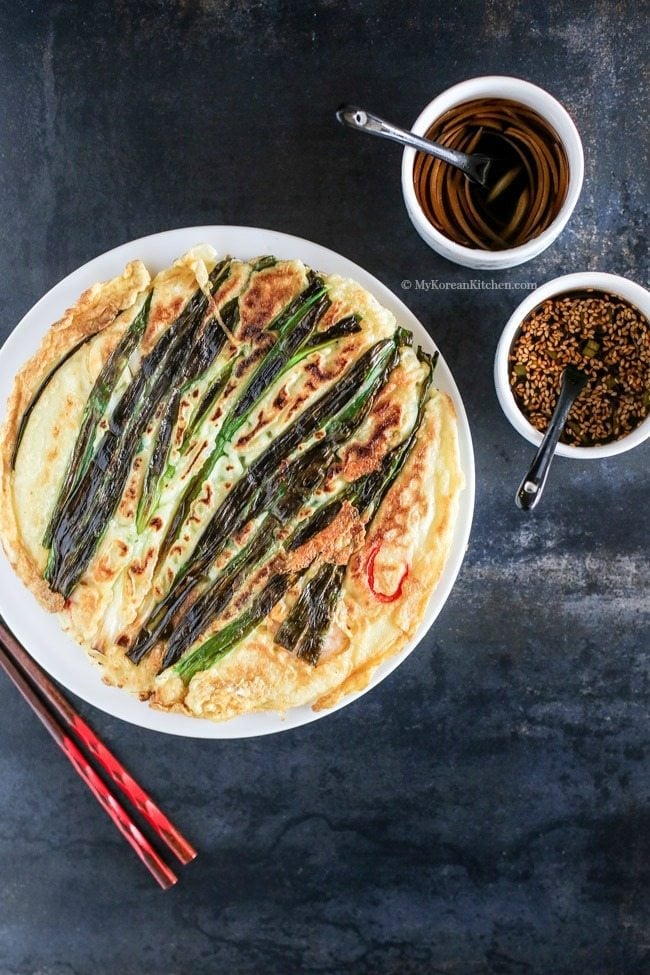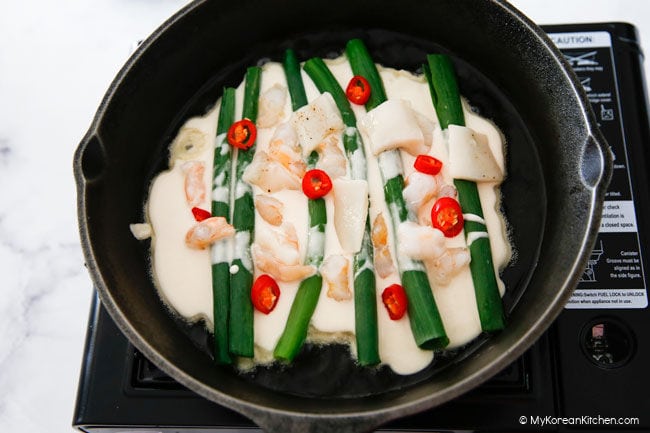Savory and delicious, pajeon is the ultimate crowd-pleaser to complement any Korean meal. Want to learn how to make ‘Haemul Pajeon’ (Korean seafood and green onion pancakes)? It’s surprisingly easy! Plus, it’s one of my most requested recipes.

What is Pajeon?
Pajeon is a type of Korean pancake that features green onions (scallions) as the star ingredient, which is why it’s often called green onion or scallion pancakes. Along with green onions, it’s made using a simple mix of homemade or store-bought Korean pancake mix, water, egg, and usually a variety of seafood.
The Korean name for this seafood and green onion pancake is Haemul Pajeon (해물 파전). I typically stick to squid (or calamari) and prawns, but feel free to toss in any seafood you like—clams, mussels, oysters, you name it!
If you’re allergic to seafood or prefer a vegetarian option, simply skip the seafood and use the rest of the ingredients. Some people even add a bit of minced beef, but I personally love seafood as the main protein in this dish.

Another Famous Pajeon: Dongnae Pajeon (동래 파전)
When it comes to pajeon, another well-known variety is Dongnae Pajeon (동래파전), which hails from Busan, South Korea. If you check out this video (produced by the Busan Metropolitan City), you’ll see that Dongnae Pajeon is quite different from my recipe.
Interestingly, not everyone is a fan of Dongnae Pajeon. Its texture is quite unique—softer and wetter compared to the crispiness of regular pajeon—which some people don’t enjoy as much.

Tips for Perfecting Your Pajeon
- From my experience, using good-quality sparkling water in your batter can make your pajeon crispier. However, it does make the batter slightly thicker, so it won’t spread as easily in the pan compared to regular water. Still, I think it’s worth a try for that extra crunch!
- Keep in mind that cooking temperatures can vary depending on your heat source (e.g., gas or electric cooktops) and the type of pan you’re using. Adjust the heat as needed—too high, and the pancake can burn quickly; too low, and the batter will soak up excess oil, leaving it soggy instead of crispy.
- If you’re planning to serve dipping sauce with your pancakes, prepare it ahead of time so you can enjoy the pancakes warm and crispy right after cooking.
- If you don’t use up all the ingredients on the same day, store them in the fridge for 1 to 2 days. Be sure to keep the pancake mixture, seafood, and vegetables in separate airtight containers.
- To reheat cooked pancakes, you can use a microwave, stovetop, or air fryer for the best results.
How To Serve
Typically, Dongnae Pajeon is paired with Cho-gochujang (초고추장), a sweet, tangy, and spicy Korean dipping sauce. On the other hand, regular Pajeon is usually served with a sweet and tangy Korean pancake dipping sauce that’s absolutely delicious. I really hope you get a chance to try my Pajeon and dipping sauce recipes—they’re a treat!

Ingredients
- 1 cup plain flour, sifted
- 1 Tbsp cornstarch
- 1 & 1/8 tsp fine salt
- 1 & 1/8 tsp garlic powder
- 1 & 1/8 tsp onion powder
- 1 cup icy cold water or sparkling water
- 12 green onion tops (green part), cleaned and cut lengthways to fit your skillet
- 100g / 3.5 ounces calamari, cleaned and cut into little finger sized pieces
- 100g / 3.5 ounces prawns, cleaned and cut into smaller pieces
- A few sprinkles ground black pepper, to marinate the seafood
- 1 egg, beaten
- (optional) 1 red chili, thinly diagonally sliced
- 6 Tbsp cooking oil, (approx. 3 Tbsp per pancake), I used rice bran oil
* 1 cup = 250 ml, 1 Tbsp = 15 ml
** This recipe is made from scratch using plain flour and other seasonings. If you choose to use Korean pancake mix (pre-mix) instead, omit the flour, cornstarch, salt, garlic powder and onion powder.
How to Make Korean Pajeon
1. Prepare a medium-sized bowl and add the flour, cornstarch, sea salt, garlic powder, onion powder, and icy cold water. Whisk well. Transfer the pancake batter to a measuring jug for easier pouring.

2. Add approximately 3 tablespoons of cooking oil to a moderately heated frying pan, spreading it evenly around the pan. Increase the heat to high and preheat the pan until the bottom is well heated. (Be cautious as the oil heats up.)

3. Wait until the oil is hot enough for cooking (about 1 minute). To check, drop a small amount of pancake batter into the pan—if it sizzles, the oil is ready. Reduce the heat to medium-high. Pour just under half a cup of pancake batter (from step 1) into the pan and spread it evenly and thinly.

4. Place 6 green onion tops on the pancake batter, parallel to each other. Pour a little bit of the pancake batter over and between the green onions, filling the gaps. Reduce the heat to medium.

5. Place some calamari, prawns, and red chilies (optional) sparingly over the green onions.

6. Use a spoon to drizzle half of the beaten egg over the pancake. While cooking, gently move the pancake in a circular motion from time to time to prevent it from sticking to the pan.

7. Flip the pancake when the top is partially cooked (this makes flipping easier and takes about 4 minutes). If needed, add more cooking oil around the edges of the pancake to help release it. Press the pancake with a spatula a couple of times to create a sizzle and make it crispy. Cook for another 3 to 4 minutes. Turn off the heat and transfer the pancake onto a plate or cutting board.

8. Repeat steps 2 to 7 with the remaining ingredients until everything is used up.
9. Slice the pancake into bite-sized pieces. Serve it with Korean pancake sauce.

More Korean Pancake Recipes
Ready to discover new Korean pancake flavors? Dive in and try these!
P.S. Got a surplus of green onions? Check out my article on how to store them properly: How to Store Green Onions. With this method, my green onions stay fresh for 5 to 6 weeks—no planting required!
How I Make It: Step-by-Step Recipe Video

Korean Seafood and Green Onion Pancakes (Haemul Pajeon)
Ingredients
- 1 cup plain flour
- 1 Tbsp cornstarch
- 1 1/8 tsp fine salt
- 1 1/8 tsp garlic powder
- 1 1/8 tsp onion powder
- 1 cup water , icy cold or quality sparkling water
- 12 green onion tops (green part), cleaned and cut lengthways to fit your skillet
- 100 g calamari (3.5 ounces), cleaned and cut into little finger sized pieces
- 100 g prawns (3.5 ounces), cleaned and cut into smaller pieces
- A few sprinkles ground black peppers , to marinate seafood
- 1 egg , beaten
- 1 red chili (optional), thinly diagonally sliced
- 6 Tbsp cooking oil (approx. 3 Tbsp per pancake), I used rice bran oil
Instructions
- Prepare a medium-sized bowl and add the flour, cornstarch, sea salt, garlic powder, onion powder, and icy cold water. Whisk well. Transfer the pancake batter to a measuring jug for easier pouring.
- Add approximately 3 tablespoons of cooking oil to a moderately heated frying pan, spreading it evenly around the pan. Increase the heat to high and preheat the pan until the bottom is well heated. (Be cautious as the oil heats up.)
- Wait until the oil is hot enough for cooking (about 1 minute). To check, drop a small amount of pancake batter into the pan—if it sizzles, the oil is ready. Reduce the heat to medium-high. Pour just under half a cup of pancake batter (from step 1) into the pan and spread it evenly and thinly.
- Place 6 green onion tops on the pancake batter, parallel to each other. Pour a little bit of the pancake batter over and between the green onions, filling the gaps. Reduce the heat to medium.
- Place some calamari, prawns, and red chilies (optional) sparingly over the green onions.
- Use a spoon to drizzle half of the beaten egg over the pancake. While cooking, gently move the pancake in a circular motion from time to time to prevent it from sticking to the pan.
- Flip the pancake when the top is partially cooked (this makes flipping easier and takes about 4 minutes). If needed, add more cooking oil around the edges of the pancake to help release it. Press the pancake with a spatula a couple of times to create a sizzle and make it crispy. Cook for another 3 to 4 minutes. Turn off the heat and transfer the pancake onto a plate or cutting board.
- Repeat steps 2 to 7 with the remaining ingredients until everything is used up.
- Slice the pancake into bite-sized pieces. Serve it with Korean pancake sauce.
Notes
- 2 pancakes will be enough for 4 servings as an appetizer.
- 1 cup = 250 ml, 1 Tbsp = 15 ml
- This recipe is made from scratch using plain flour and other seasonings. If you choose to use Korean pancake mix (pre-mix) instead, omit the flour, cornstarch, salt, garlic powder and onion powder.
Nutrition Info (per serving)
The nutrition information shown is an estimate provided by an online nutrition calculator. It should not be considered a substitute for a professional nutritionist’s advice.



